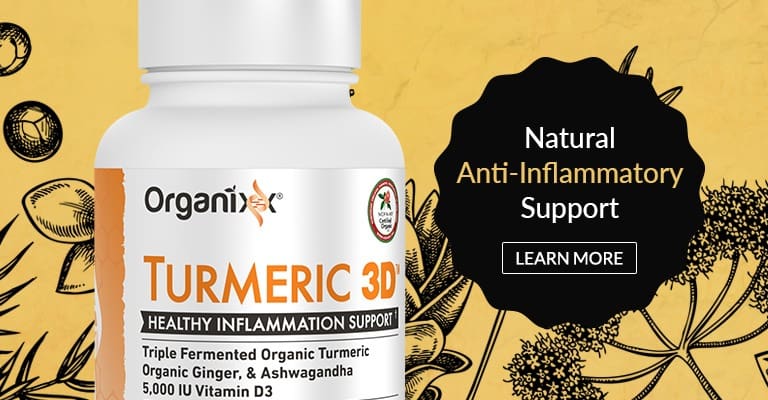Video Transcript:
Today, I want to share with you why I love Turmeric 3D so much for not just inflammation reduction and balancing our stress hormone, but also just overall supporting our brain function, our digestive function, and our cardiovascular function.
Maximizes Benefit & Bioavailability with Fermented Botanicals
One of the awesome things that we have harnessed here at Organixx is we have a unique fermentation process of the ingredients in a multitude of our supplements. And Turmeric 3D is a part of that fermentation process, which allows you as a consumer to get the max benefits of the turmeric and the ashwagandha, and the other botanical powerhouses in Turmeric 3D that will help lower inflammation, reduce excess fluid weight and retention, and can also help restore and rejuvenate your immune state, balance your stress levels, calm hormonal imbalances.
Lowers Inflammation
And it even helps with your brain-based inflammation, which we’re seeing now with a lot of post-COVID infections. You don’t even have to qualify as a long COVID or a long hauler, but there are a lot of individuals that are still having residual inflammation and even patients that have auto-immunity or folks that have lymphedema or lipedema, or just overall notice they’re carrying more cellulite or excess weight. Those are all signs of an inflammatory state.
So, using Turmeric 3D allows you to harness the potency of turmeric, which has been heavily researched in its amazing power to lower inflammation markers in your body. It also has ashwagandha, which is a wonderful stress-balancing herbal, and in a fermented form, it actually is going to be more bioavailable. So, you need less and you get more power and more potency.
Addresses Vitamin D3 Deficiency
So, I’m excited to share that with you because one of the things that we love, not only are you getting the turmeric and the botanicals, but we also add D3 in a form, it’s a 5,000 IU form, which vitamin D3, I find almost all of my patients when I do a blood spot test, we do blood spot testing in my clinic, they are all in low or suboptimal levels or ranges of vitamin D3. And vitamin D3 has a lot to do with your mental outlook. It is a hormone precursor. It’s a building block. It’s an ingredient for your body, balancing your stress levels, your reproductive hormone levels, and overall, every cell has receptivity to vitamin D.
Optimizes Overall Wellness
So, I’m very, very excited to recommend the Turmeric 3D. This is a powerful supplement here that has anti-inflammatory effects. It has stress-lowering, hormone-balancing, and overall will help support your body and optimize your wellness.
So I hope you check this out and it’s such a great resource for anybody who might be looking for a way to support their overall wellness and just know inflammation is the root of every illness and disease. Taming and calming inflammation levels in your body will increase and optimize your overall wellness.
Turmeric 3D from Organixx provides you one of the most “bioavailable” forms of turmeric due to its unique fermentation process. This means your body experiences the maximum benefits of the purest, most potent turmeric available!
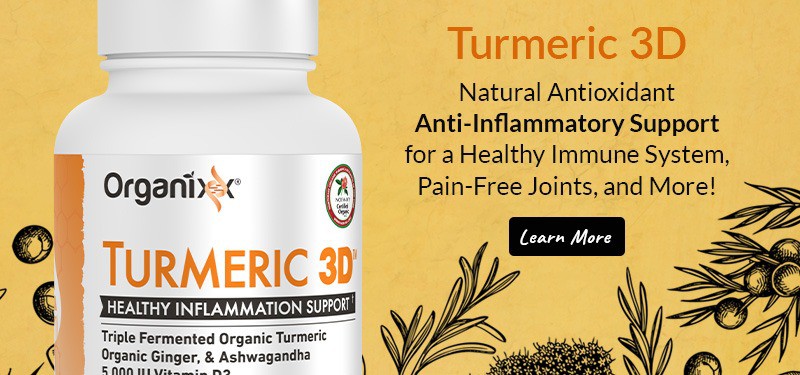
As we know all too well by now, a novel epidemic began in the city of Wuhan in Hubei, China, in late 2019. The previously unknown organism responsible – a highly contagious coronavirus – was named COVID-19 by the World Health Organization (WHO) in February 2020 [1,2]. Previous coronavirus epidemics have included the deadly severe acute respiratory syndrome (SARS) [3,4] and the Middle East respiratory syndrome (MERS) [5,6,7].
More than a year later, the COVID-19 pandemic has decimated economies and overloaded healthcare systems around the world. As of early December 2020, nearly 70 million COVID-19 cases had been reported across 188 countries and territories, resulting in an estimated 1.6 million deaths [8].
COVID-19 patients exhibit a wide range of symptoms, including cough and difficulty breathing [9]. They may also exhibit other symptoms, such as:
- fever
- chills
- repeated shaking with chills
- muscle or body aches
- headache
- sore throat
- new loss of smell and taste
- congestion or runny nose
- nausea or vomiting
- diarrhea
Most infected people are either asymptomatic or have mild symptoms. However, a small but significant proportion of COVID-19 patients become critically ill [10] and died. Many of these latter patients did not exhibit severe symptoms initially, but then went on to develop acute respiratory distress syndrome (ARDS) and multiple-organ failure while in the later stages of the disease, or sometimes even while recovering [11].

In acute respiratory distress syndrome (ARDS), there is widespread inflammation in the lungs. Fluid collects in the air sacs or alveoli, leading to oxygen deprivation. Symptoms of ARDS include shortness of breath, rapid breathing, and bluish skin color.
Person-to-person spread of the COVID-19 virus takes place when an uninfected person comes into close contact with an infected person and is exposed to coughing, sneezing, respiratory droplets or aerosols. These aerosols may contain either virus particles or liquid respiratory droplets containing virus particles and can enter the lungs via inhalation through the nose or mouth [12].
COVID-19 and Vitamin D: Is There a Connection?
COVID-19-related deaths have been higher in some countries and populations than others. The relative proportion of elderly people, accessibility and quality of healthcare, as well as socioeconomic factors are partly responsible for these differences [13].
An important factor that appears to influence the outcome of COVID-19 infections is vitamin D status. Elderly people and others who are likely to be vitamin D deficient appear to be at greater risk for poorer outcomes.
Back in 1981, a general practitioner known as Robert Edgar Hope-Simpson had proposed that a “seasonal stimulus” closely linked to the sun’s rays might explain the seasonality of flu epidemics [14].
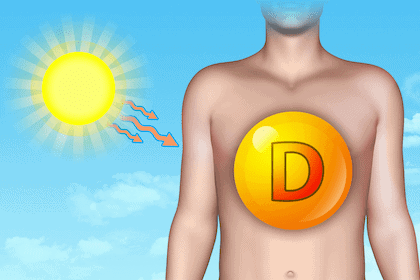
We now know that ultraviolet-B radiation in the sun’s rays triggers vitamin D production in the skin. Vitamin D deficiency is a common winter phenomenon, especially in northern latitudes, so perhaps it’s not a coincidence that COVID-19 started to spread in Northern Europe in the winter of 2019.
In these countries, as well as in Italy and Spain, elderly people – who are more likely to be vitamin D deficient – were seen to be the most vulnerable to COVID-19 [15]. Indeed, some aspects of COVID‐19 infections, such as excessive blood clotting, seem to get less severe in the summer [16].
People with darker skin, who are more likely to be vitamin D deficit, have had poorer outcomes when infected with COVID-19. Finally, as the exception that proves the rule, Nordic countries in Northern Europe have had exceptionally low mortality rates, possibly because many foods in these countries are fortified with vitamin D [17,18].
Vitamin D deficiency has previously been shown to increase the risk of acute respiratory disorders. Also, people infected with COVID-19 are more likely to suffer serious consequences, the older they are and if they already have chronic diseases, known as comorbidity. Both aging and comorbidity have previously been linked to lower vitamin D levels [19].
Vitamin D Deficiency and Upper Respiratory Infections: What We Know So Far
Lack of sun exposure and vitamin D deficiency has previously been linked to a greater risk of developing autoimmune diseases, cardiovascular disease, and cancer [20].
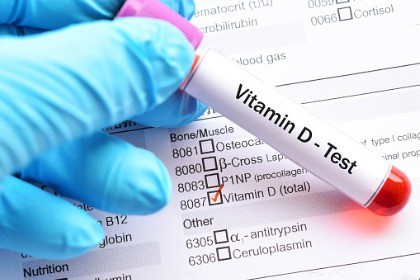
Low vitamin D status is also associated with a greater susceptibility to infectious diseases, especially upper respiratory tract infections. For instance, a 2017 meta-analysis of individual data of over 11,000 participants from 25 randomized, double-blind, placebo-controlled trials [21,22] showed that vitamin D2 or D3 supplementation protected against acute respiratory tract infections.
Interestingly, patients with very low (less than 10 ng/mL or 25 nmol/L) levels of vitamin D were seen to gain the most benefits from supplementation.
Similarly, a randomized, double-blind, placebo-controlled trial showed that schoolchildren who were given vitamin D3 supplements daily were significantly less susceptible to both flu and asthma attacks [23].
Vitamin D deficiency has been shown to contribute to acute respiratory distress syndrome (ARDS) [24]. The likelihood of a fatal outcome increases with age and with the presence of chronic diseases – both of which, as we have already seen, have been linked to lower vitamin D levels.
Vitamin D and Immunity
Vitamin D is essential for the efficient absorption of calcium and phosphate, both of which are needed for bone growth and maintaining bone strength. More recent research shows that vitamin D also plays a role in determining your risk of developing cancer and diabetes, as well as cardiac and gastrointestinal diseases [25].
Vitamin D3 or cholecalciferol is the form that is made in your skin in response to sunlight. Vitamin D3 is converted to 25-hydroxyvitamin D or calcidiol (the storage form of vitamin D) in the liver. In your kidneys – but also in alveolar cells and macrophages in the lungs – calcidiol is converted to the active form, 1, 25-dihydroxyvitamin D or calcitriol [26].
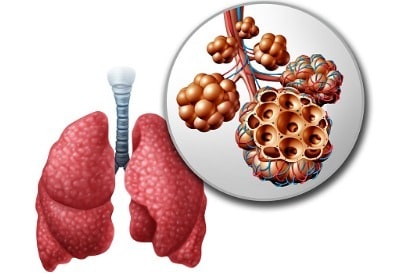
Alveoli are tiny air sacs in your lungs that take up oxygen from the air you breathe, in exchange for carbon dioxide. Alveolar cells play a role in this exchange. Macrophages are large, specialized immune cells that recognize, engulf, and destroy infected, cancerous, damaged, and dead cells.
The extent of “local” vitamin D activation in alveolar cells in the lungs has been shown to be directly related to the body’s ability to fight off acute respiratory infections [27,28]. Vitamin D triggers multiple antibacterial and antiviral actions of immune cells [29,30]. On the other hand, vitamin D deficiency reduces the immune system’s ability to fight off bacterial and viral invasions [31].
Specifically, vitamin D helps the body fight viral infections in multiple ways:
- It stimulates the production of small proteins or peptides in immune cells and in the cells lining the inner walls of our airways. These peptides have been shown to slow or even shut down viral replication, making upper respiratory viral infections – including COVID-19 – less likely to occur [32,33].
- Vitamin D lowers levels of pro-inflammatory immune signaling molecules known as cytokines, which trigger inflammation that injures the lungs in upper respiratory tract infections, leading to pneumonia. Vitamin D also increases levels of anti-inflammatory cytokines [34].
- Finally, vitamin D appears to tone down the aggressive, hyperactive immune response known as a “cytokine storm.” Although cytokine storms seen in COVID-19 patients may be different from those seen in other health conditions [35], they have nevertheless been linked to a greater likelihood of lung injury, multi-organ failure, and poorer health outcomes in critically ill COVID-19 patients [36].
Low Vitamin D Is An Independent Risk Factor for Covid-19
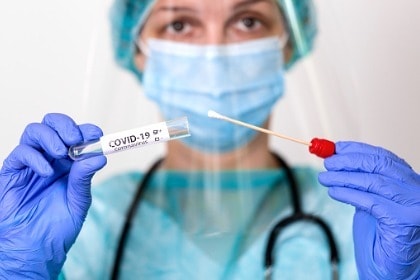
In a study of nearly 500 people, the relative risk of testing positive for COVID-19 was seen to be nearly twice as much for patients who were deficient in vitamin D, compared to patients who had sufficient vitamin D levels [37].
Further, based on a study involving 782 COVID-19 positive patients and 7,025 COVID-19 negative patients, Israeli scientists have concluded that a low vitamin D level is an independent risk factor for COVID-19 infection and hospitalization [38].
According to Dr. Eugene Merzon, the lead author of the study:
“The main finding of our study was the significant association of low plasma vitamin D level with the likelihood of COVID-19 infection among patients who were tested for COVID-19, even after adjustment for age, gender, socio-economic status and chronic, mental and physical disorders.”
Severely ill COVID-19 patients who required intensive care were seen to have higher levels of inflammatory markers, be much more likely to be deficient in vitamin D, and much more likely to die, than were asymptomatic patients [39].
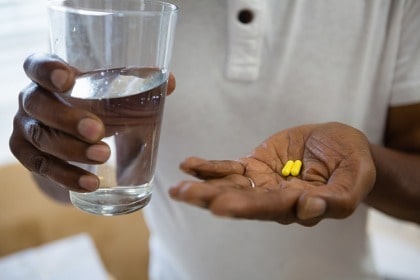
In a small-scale clinical trial, asymptomatic or mildly symptomatic patients supplemented daily with a high dose (60,000 International Units, or IU) of vitamin D3 for 7-14 days were shown to be significantly more likely to test negative for COVID-19 than patients in the control group [40].
The evidence indicates that the odds of COVID-19 patients having a mild clinical outcome increase when vitamin D levels increase – and the odds of having a critical outcome increase when vitamin D levels decrease [41]. Further, raising vitamin D levels is likely to improve clinical outcomes and prevent adverse outcomes.
Professor Rose Anne Kenny of Trinity College Dublin, the lead investigator of the Irish Longitudinal Study on Ageing (TILDA), has stated that public health bodies in the UK should recommend that everyone take vitamin D supplements during the pandemic, especially care home residents [42,43]. According to her, “The circumstantial evidence is very strong”.
Adrian Martineau, lead author of the 2017 meta-analysis describing the effects of vitamin D supplementation on the risk of developing upper respiratory tract infections has stated:
“At best vitamin D deficiency will only be one of many factors involved in determining outcome of COVID-19, but it’s a problem that could be corrected safely and cheaply; there is no downside to speak of, and good reason to think there might be a benefit” [44].
Dozens of Clinical Trials Assessing Role of Vitamin D in Covid-19 Management

More and more health experts now agree that vitamin D supplements are likely to offer a relatively easy option to decrease the impact of the COVID-19 pandemic [45]. In late Dec 2020, more than 100 scientists and doctors sent an open letter to world leaders warning of the danger of vitamin D deficiency [46].
There are also currently more than 60 clinical trials being conducted all over the world to assess the role of vitamin D in COVID-19 management [47].
One such randomized, open-label, double-masked clinical trial concluded that in patients hospitalized due to COVID-19, a high dose of vitamin D significantly reduced the need for intensive care [48].
Some researchers have even suggested that vitamin D might be a better, safer, and cheaper option than commercially available drugs used in patients with severe COVID-19 infections [49].
Vitamin D: What Is Sufficient?
Vitamin D levels between 20-50 ng/mL (30-125 nmol/L) are considered normal for the average adult. A person is considered insufficient if their vitamin D levels are between 12-20 ng/mL or 30-50 nmol/L. In adults, deficiency (less than 12 ng/mL or 30 nmol/L) can lead to osteomalacia or softening of the bones and osteoporosis (“porous bone”), a bone disease in which bones become weak and brittle.
The people most likely to have less than ideal vitamin D levels include:
- infants
- the elderly
- people with dark skin people
- city-dwellers who work mostly indoors
- people who live in countries in the northern hemisphere above 37 degrees of latitude
- the overweight and obese
- people with insulin resistance or who are diabetic
- people with chronic inflammatory conditions
- smokers
Not surprisingly, all of these people, especially the elderly, tend to have worse than average outcomes when infected with COVID-19.
To reduce the risk of COVID-19 infection, experts are now recommending that an adult take 10,000 IU per day of vitamin D3 for a few weeks to rapidly raise their levels, followed by a maintenance dose of 5,000 IU per day.
Their goal should be to raise vitamin D levels to between 40-60 ng/mL (100-150 nmol/L). For people infected with COVID-19, even higher doses might be useful.
Commercial supplements are available either as vitamin D2 or D3. Vitamin D2, also known as ergocalciferol, is typically found in mushrooms such as portobello and shiitake. Vitamin D3 is naturally present in fatty fish such as cod, swordfish, tuna, mackerel, and salmon. Milk is not a natural source, but in the U.S. milk is fortified with vitamin D, as are some yogurts, breakfast cereals, and fruit juices.
Some Considerations When Taking Vitamin D
The more vitamin D you consume, the more calcium ends up in your blood. Calcium buildup can lead to its accumulation in soft tissue such as kidneys and blood vessels – a process known as calcification, which increases the risk of chronic diseases.
Taking supplementary vitamin K2 along with vitamin D ensures that excess calcium ends up in the teeth and bones, where it belongs, and is a good idea especially with long-term supplementation. Both vitamin D and K2 are fat-soluble vitamins, absorbed best when consumed with a meal containing healthy fats.
Magnesium is essential for converting vitamin D into its active form. Fruits, vegetables, grains, and nuts are all excellent sources of magnesium. Alternatively, magnesium citrate can also be consumed as a supplement. Finally, both vitamin D and zinc play key roles in activating the body’s immune response. Taking them together is likely to complement their actions and provide greater health benefits.
Consult with your primary healthcare provider to have your vitamin D levels checked and always consult with your doctor before taking new supplements to ensure they are appropriate for you and your health status.
Tip: Turmeric 3D Contains 5,000 IU of Vitamin D
Each serving (2 capsules) of Turmeric 3D from Organixx contains 125mcg (5,000 iu) of vitamin D.
Turmeric 3D from Organixx provides you one of the most “bioavailable” forms of turmeric due to its unique fermentation process. This means your body experiences the maximum benefits of the purest, most potent turmeric available!



